From left, clockwise: Pope Francis is elected to the Papacy in the 2013 papal conclave; The Dhaka garment factory collapse in Bangladesh kills over 1,000 people; Edward Snowden becomes internationally famous for leaking classified NSA wiretapping information; Protests occur amid the coup d'état that overthrew President Mohamed Morsi of Egypt; The Chelyabinsk meteor rockets across the Russian morning sky; The Boston Marathon bombing marks the first terrorist attack in the United States since 9/11; Smoke rises as a result of the Westgate shopping mall attack in Nairobi, Kenya, carried out by Al-Shabaab militants.
From left, clockwise: The H1N1 virus was responsible for the 2009 swine flu pandemic; Barack Obama becomes the first African American to become President of the United States; US Airways Flight 1549 crash-lands in the Hudson River with no fatalities, with the event becoming known as the "Miracle on the Hudson"; the "King of Pop" Michael Jackson died in 2009; Bitcoin is initially launched by the pseudonymous name Satoshi Nakamoto; the 2009 L'Aquila earthquake strikes central Italy; the vertical stabilizer of Air France Flight 447 is pulled out from the Atlantic Ocean.
From left, clockwise: Bombed-out buildings in Ankara following the 2016 Turkish coup d'état attempt; the impeachment trial of Brazilian President Dilma Rousseff; Damaged houses, Damaged during the 2016 Nagorno-Karabakh conflict; A scene from the opening ceremony of the 2016 Summer Olympics in Rio de Janeiro, Brazil; Queues outside a bank to exchange demonetised banknotes during the 2016 Indian banknote demonetisation; the UK votes to leave the EU in 2016; The Girardet bridge in Düsseldorf with its four pokéstops; Donald Trump is elected as U.S. President in 2016 during a period of intensifying political polarization in the U.S.
From left, clockwise: Stocking up supplies and personal protective equipment (PPE) for the Western African Ebola virus epidemic; Citizens examining the ruins after the Chibok kindap; Bundles of water inside of a C-17 Globemaster III in the War against the Islamic State; Thai soldiers at the Chang Phueak Gate during the 2014 Thai coup d'état; Pro-independence campaigners in the 2014 Scottish independence referendum; A scene from the opening ceremony of the 2014 Winter Olympics in Sochi, Russia; Crimea is annexed by Russia in 2014
From top to bottom, left to right: a protester partaking in Occupy Wall Street heralds the beginning of the Occupy movement; protests against Libyan dictator Muammar Gaddafi, who was killed that October; a young man celebrates the independence of South Sudan, the world's newest country; the 2011 Tōhoku earthquake and tsunami devastates Eastern Japan and kills nearly 20,000 people; Minecraft is released and goes on to become the best-selling video game; the 2011 Norway attacks mark the rise of white supremacist terrorism across the west; The U.S. national security team gathered in the White House Situation Room to monitor the progress of Operation Neptune Spear; Anti-government protests called the Arab Spring arose in 2010–2011, and as a result, many governments were overthrown
From left, clockwise: 2010 Chile earthquake was one of the strongest recorded in history; Eruption of Eyjafjallajökull disrupts air travel in Europe; A scene from the opening ceremony of the 2010 Winter Olympics in Vancouver, British Columbia, Canada; Deepwater Horizon drilling rig explosion was the worst marine oil spill in history; North Korean artillery attacks Yeonpyeong Island.; Kyrgyzstan Revolution: people entering the White House in Bishkek on 7 April.; Remains of Tu-154 after crash on April 10, 2010 that killed Polish president Lech Kaczyński; Child is treated for injuries following 2010 Haitian earthquake which killed over an estimated 100,000 people.
From left, clockwise: Lehman Brothers went bankrupt following the Subprime mortgage crisis; Cyclone Nargis killed more than 138,000 in Myanmar; A scene from the opening ceremony of the 2008 Summer Olympics in Beijing; the 2008 Sichuan earthquake kills over 87,000; a destroyed Georgian T-72 tank during the Russo-Georgian War; the Trident Hotel in Mumbai was the site of the November 2008 Mumbai attacks;a line of detritus in a backyard made during the December, 2008 Kingston Fossil Plant coal fly ash slurry spill ; Poster in Pristina celebrating the Independence of Kosovo from Serbia.
From left, clockwise: Hurricane Katrina in the Gulf of Mexico; the highest roller coaster in the world, Kingda Ka, opens to the public; "Me at the zoo", the first video ever to be uploaded to YouTube; Eris was discovered in January 2005 by a Palomar Observatory–based team; Saddam Hussein sits before an Iraqi judge at a courthouse in Baghdad; the shrine and resting place for Rafic Hariri in September; the Mars Reconnaissance Orbiter is launched from Kennedy Space Center, designed to explore Mars; The Live 8 concert in the Tiergarten, Berlin.

From left, clockwise: Steve Jobs unveils Apple's first iPhone; TAM Airlines Flight 3054 overruns a runway and crashes into a gas station, killing almost 200 people; Former Pakistani Prime Minister Benazir Bhutto is assassinated; 2007 marked the beginning of the Subprime mortgage crisis in the United States; A surge of troops is sent to fight in the Iraq War; a gunman kills 32 people at Virginia Tech; Google Street View is unveiled to the world;The Treaty of Lisbon is signed by member states of the European Union

From left, clockwise: Wikipedia is launched, making it the world's largest online encyclopedia; Enron files for bankruptcy after a major scandal; Foot-and-mouth disease breaks out in the United Kingdom; The United States invades Afghanistan to begin the War on terror; The 2001 Gujarat earthquake kills between 13,000 and 20,000 people; Apple Inc. launches the first iPod after releasing iTunes earlier in the year; President George W. Bush announces the War on terror and demands that the Taliban hand over Al-Qaeda leader Osama bin Laden; The Twin Towers of the World Trade Center burn and eventually collapse after being struck with hijacked planes during the 9/11 attacks.

From left, clockwise: Protests against Bush v. Gore after the 2000 United States presidential election; Heads of state meet for the Millennium Summit; The International Space Station in its infant form as seen from STS-97; The 2000 Summer Olympics are held in Sydney; A U.S. Air Force MH-53 flies over the 2000 Mozambique flood; An Air France Concorde similar to the one that crashed after takeoff from Charles de Gaulle Airport; The USS Cole is bombed by Al-Qaeda; Times Square after the ball drop that heralded the New Millennium.
错误:图像不正确或者不存在。

From left, clockwise: The 2002 Winter Olympics are held in Salt Lake City; Queen Elizabeth The Queen Mother and Princess Margaret, Countess of Snowdon both die within weeks of each other; East Timor gains independence from Indonesia and is admitted to the United Nations; an Armenian postage stamp depicts the 2002 FIFA World Cup, which was held in South Korea and Japan; the Department of Homeland Security is created in the wake of 9/11 to counter further terrorist threats against the United States; the 2002 Überlingen mid-air collision kills 71 people; FBI agents investigate a crime scene related to the D.C. sniper attacks; the Euro becomes the official currency of the European Union.

From left, clockwise: The crew of STS-107 perished when the Space Shuttle Columbia disintegrated during reentry into Earth's atmosphere; SARS became an epidemic in China, and was a precursor to SARS-CoV-2; A destroyed building in Bam, Iran after the 2003 Bam earthquake killed 30,000 people; A U.S. Army M1 Abrams tank patrols the streets of Baghdad after the city fell to U.S.-led forces; Abuse and torture of Iraqi prisoners at Abu Ghraib prison by U.S. personnel; Protests in London against the Invasion of Iraq; "Mission Accomplished" became an ironic symbol of the protractedness of the Iraq War after President George W. Bush's infamous speech; a statue of Saddam Hussein is toppled in Baghdad after he was deposed during the Iraq War.

From left, clockwise: The funeral procession of King Hussein of Jordan in Amman; the 1999 İzmit earthquake kills over 17,000 people in Turkey; the Columbine High School massacre becomes one of the first major school shootings in the United States; the Year 2000 problem, or "Y2K", becomes a major technological concern in the lead up to the year 2000; the Millennium Dome opens in London in anticipation for the Millennium celebrations; Napster, an online music downloading platform, is launched and becomes a source of online piracy; NASA loses both the Mars Climate Orbiter and the Mars Polar Lander; a destroyed t-55 tank lies near Prizren during the Kosovo War.
From left, clockwise: Mourners on Zahran street hold up portrait of the recently deceased King Hussein of Jordan; Collapsed building following the 1999 Izmit earthquake; Mourners outside JFK jrs Loft apt after the John F. Kennedy Jr. plane crash; The opening ceremony for the 1999 UEFA Champions League Final; NASA Lunar Prosepector; Napster, a music downloading service, debuts; Artist's depiction of the Mars Polar Lander on Mars; Destroyed tank near Prizren destroyed during the Kosovo War
错误:图像不正确或者不存在。
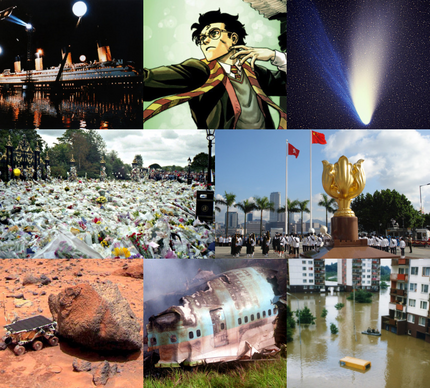
From left, clockwise: The movie set of Titanic, which became the highest-grossing movie in history for over a decade; The first book in J.K. Rowling's Harry Potter series, Harry Potter and the Philosopher's Stone, is published; Comet Hale-Bopp passes by Earth and becomes one of the most observed comets of the 20th century; Golden Bauhinia Square, where sovereignty of Hong Kong is handed over from the United Kingdom to the People's Republic of China; the 1997 Central European flood kills 114 people in the Czech Republic, Poland, and Germany; Korean Air Flight 801 crashes during heavy rain on Guam, killing 229; Mars Pathfinder and Sojourner land on Mars; Flowers are left outside of Kensington Palace following the Death of Diana, Princess of Wales in a car crash in Paris.

From left, clockwise: A bomb explodes at Centennial Olympic Park in Atlanta, set off by a radical anti-abortionist; The center fuel tank explodes on TWA Flight 800, causing the plane to crash and killing everyone on board; Eight people die in a blizzard on Mount Everest; Dolly the Sheep becomes the first mammal to have been cloned from an adult somatic cell; The Port Arthur Massacre occurs on Tasmania, and leads to major changes in Australia's gun laws; Macarena, sung by Los del Río and remixed by The Bayside Boys, becomes a major dance craze and cultural phenomenon; Ethiopian Airlines Flight 961 crash-ditches off of the Comoros Islands after the plane was hijacked; the 1996 Summer Olympics are held in Atlanta, marking the Centennial (100th Anniversary) of the modern Olympic Games.

From left, clockwise: O. J. Simpson is acquitted of the murders of Nicole Brown Simpson and Ronald Goldman from the year prior in "The Trial of the Century" in the United States; The Great Hanshin earthquake strikes Kobe, Japan, killing 5,000-6,000 people; The Unabomber Manifesto is published in several U.S. newspapers; Gravestones mark the victims of the Srebrenica massacre near the end of the Bosnian War; Over 150,000 people gather for the Million Man March in Washington, D.C.; The first exoplanet, 51 Pegasi b, is discovered; Space Shuttle Atlantis docks with the Space station Mir in a display of U.S.-Russian cooperation; The Alfred P. Murrah Federal Building in Oklahoma City is bombed by domestic terrorists, killing 168.

From left, clockwise: The 1994 Winter Olympics are held in Lillehammer, Norway; The Kaiser Permanente building after the 1994 Northridge earthquake; A model of the MS Estonia, which sank in the Baltic Sea; Nelson Mandela casts his vote in the 1994 South African general election, in which he was elected South Africa's first president, and which effectively brought Apartheid to an end; NAFTA, which was signed in 1992, comes into effect in Canada, the United States, and Mexico; The first passenger rail service to utilize the newly-opened Channel tunnel; The 1994 FIFA World Cup is held in the United States; Skulls from the Rwandan genocide, in which over half a million Tutsi people were massacred by Hutus.

From left, clockwise: The Oslo I Accord is signed in an attempt to resolve the Israeli–Palestinian conflict; The Russian White House is shelled during the 1993 Russian constitutional crisis; Czechoslovakia peacefully dissolves into the Czech Republic and Slovakia; The ATF besieges a compound belonging to David Koresh and the Branch Davidians in a search for illegal weapons, which ends in the building being set alight and killing most inside- the event serves as inspiration for Timothy McVeigh to commit the Oklahoma City bombing in 1995; Eritrea gains independence; A major snow storm passes over the United States and Canada, leading to over 300 fatalities; Infamous drug lord and narcoterrorist Pablo Escobar is killed by Colombian special forces; Ramzi Yousef and other Islamic terrorists detonate a truck bomb in the subterranean garage of the North Tower of the World Trade Center in an attempt to destroy the site.

From left, clockwise: The Cypress structure collapses as a result of the 1989 Loma Prieta earthquake, killing motorists below; The proposal document for the World Wide Web is submitted; The Exxon Valdez oil tanker runs aground in Prince William Sound, Alaska, causing a large oil spill; The Fall of the Berlin Wall marks the beginning of the end of Communism in Eastern Europe, and leads to German reunification the next year; The United States invades Panama to depose Manuel Noriega; The Singing Revolution led to the independence of the Baltic states of Estonia, Latvia, and Lithuania from the Soviet Union; The stands of Hillsborough Stadium in Sheffield, Yorkshire, where the Hillsborough disaster occurred; Students demonstrate in favor of democracy in Tiananmen Square, where many ended up being massacred by forces of the Chinese Communist Party.

From left, clockwise: Anti-government protests called the Arab Spring arose in 2010–2011, and as a result, many governments were overthrown, including when Libyan dictator Muammar Gaddafi was killed; Crimea is annexed by Russia in 2014; ISIS/ISIL perpetrates terrorist attacks and captures territory in Syria and Iraq; climate change awareness and the Paris Agreement; the Event Horizon Telescope captures the first image of a black hole in 2019; Obergefell v. Hodges legalizes same-sex marriage in the United States in 2015; increasing use of digital and mobile technologies; the UK votes to leave the EU in 2016, on a rising tide of populism throughout the West during the decade.
| Millennium |
|---|
| 3rd millennium |
| Centuries |
| Decades |
| Years |
| Categories |
</imagemap>

From top left, clockwise: The World Trade Center on fire and the Statue of Liberty during the 9/11 attacks in 2001; the euro enters into European currency in 2002; a statue of Saddam Hussein being toppled during the Iraq War in 2003, and in 2006, Hussein would be executed for crimes against humanity; U.S. troops heading toward an army helicopter in Afghanistan during the War on Terror; social media through the Internet spreads across the world; a Chinese soldier gazes at the 2008 Summer Olympics commencing in Beijing; the largest economic crisis since the Great Depression hits the world in 2008; a tsunami from the Indian Ocean earthquake kills over 230,000 in 2004, and becomes the strongest earthquake since the 1964 Alaska earthquake

From top-left, clockwise: The Hubble Space Telescope orbits the Earth after it was launched in 1990; American F-16s and F-15s fly over burning oil fields in Operation Desert Storm, also known as the 1991 Gulf War; the signing of the Oslo Accords on 13 September 1993; the World Wide Web gains a public face at the start of the decade and gains massive popularity worldwide; Boris Yeltsin and followers stand on a tank in defiance to the August Coup, which leads to the dissolution of the Soviet Union on 26 December 1991; Dolly the sheep is the first mammal to be cloned from an adult somatic cell; the funeral procession of Diana, Princess of Wales, who died in 1997 in a car crash in Paris, and was mourned by millions; hundreds of thousands of Tutsi people are killed in the Rwandan genocide of 1994. This would become a factor in initiating the Second Congo War of 1998.

From left, clockwise: The first Space Shuttle, Columbia, lifts off in 1981; US president Ronald Reagan and Soviet leader Mikhail Gorbachev ease tensions between the two superpowers, leading to the end of the Cold War; The fall of the Berlin Wall in 1989 is considered to be one of the most momentous events of the 1980s; In 1981, the IBM Personal Computer is released; In 1985, the Live Aid concert is held in order to fund relief efforts for the famine in Ethiopia during the time Mengistu Haile Mariam ruled the country; Pollution and ecological problems persisted when the Soviet Union and much of the world is filled with radioactive debris from the 1986 Chernobyl disaster, and in 1984, when thousands of people perished in Bhopal during a gas leak from a pesticide plant ; The Iran–Iraq War leads to over one million dead and $1 trillion spent, while another war between the Soviets and Afghans leaves over 2 million dead.

Clockwise from top left: U.S. President Richard Nixon doing the V for Victory sign after his resignation from office following the Watergate scandal in 1974; The United States was still involved in the Vietnam War in the early decade. The New York Times leaked information regarding the nation's involvement in the war. Political pressure led to America's withdrawal from the war in 1973, and the Fall of Saigon in 1975; the 1973 oil crisis puts the United States in gridlock and causes economic damage throughout the developed world; both the leaders of Israel and Egypt shake hands after the signing of the Camp David Accords in 1978; in 1971, the Pakistan Armed Forces commits the 1971 Bangladesh genocide to curb independence movements in East Pakistan, killing 300,000 to 3,000,000 people; this consequently leads to the Bangladesh Liberation War; the 1970 Bhola cyclone kills an estimated 500,000 people in the densely populated Ganges Delta region of East Pakistan in November 1970, and became the deadliest natural disaster in 40 years; the Iranian Revolution of 1979 ousts Mohammad Reza Pahlavi who is later replaced by an Islamic theocracy led by Ayatollah Khomeini, meanwhile, American hostages would be held by Iran until 1981; the popularity of the disco music genre peaks during the mid-to-late 1970s.
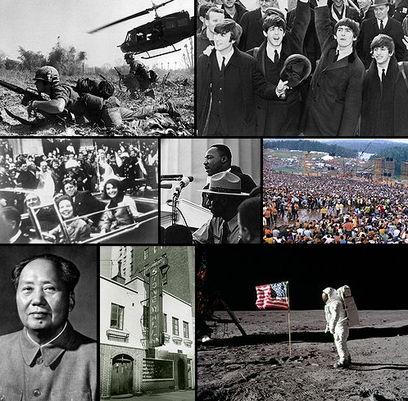
Clockwise from top left: U.S. soldiers during the Vietnam War; the Beatles led the British Invasion of the U.S. music market; a half-a-million people participate in the 1969 Woodstock Festival; Neil Armstrong and Buzz Aldrin walk on the Moon during the Cold War-era Space Race; the Stonewall Inn; China's Mao Zedong initiates the Great Leap Forward plan which fails and brings mass starvation in which 15 to 55 million people died by 1961, and in 1966, Mao starts the Cultural Revolution, which purged traditional Chinese practices and ideas; John F. Kennedy is assassinated in 1963, after serving as President for three years; Martin Luther King Jr. makes his famous "I Have a Dream" speech to a crowd of 250,000.

Top, L-R: U.S. Marines engaged in street fighting during the Korean War, c. late September 1950; The first polio vaccine is developed by Jonas Salk.
Centre, L-R: US tests its first thermonuclear bomb with code name Ivy Mike in 1952. A 1954 thermonuclear test, code named Castle Romeo, is shown here; In 1959, Fidel Castro overthrows Fulgencio Batista in the Cuban Revolution, which results in the creation of the first and only communist government in the Western hemisphere; Elvis Presley becomes the leading figure of the newly popular music genre of rock and roll in the mid-1950s.
Bottom, L-R: Smoke rises from oil tanks on Port Said following the invasion of Egypt by Israel, United Kingdom and France as part of the Suez Crisis in late 1956; The Hungarian Revolution of 1956; The Soviet Union launches Sputnik 1, the first artificial satellite to orbit the Earth, in October 1957. This starts the Space Race between the Soviet Union and the United States.
Centre, L-R: US tests its first thermonuclear bomb with code name Ivy Mike in 1952. A 1954 thermonuclear test, code named Castle Romeo, is shown here; In 1959, Fidel Castro overthrows Fulgencio Batista in the Cuban Revolution, which results in the creation of the first and only communist government in the Western hemisphere; Elvis Presley becomes the leading figure of the newly popular music genre of rock and roll in the mid-1950s.
Bottom, L-R: Smoke rises from oil tanks on Port Said following the invasion of Egypt by Israel, United Kingdom and France as part of the Suez Crisis in late 1956; The Hungarian Revolution of 1956; The Soviet Union launches Sputnik 1, the first artificial satellite to orbit the Earth, in October 1957. This starts the Space Race between the Soviet Union and the United States.

Above title bar: events during World War II (1939–1945): From left to right: Troops in an LCVP landing craft approaching Omaha Beach on D-Day; Adolf Hitler visits Paris, soon after the Battle of France; The Holocaust occurs as Nazi Germany carries out a programme of systematic state-sponsored genocide, during which approximately six million European Jews are killed; The Japanese attack on the American naval base of Pearl Harbor launches the United States into the war; An Observer Corps spotter scans the skies of London during the Battle of Britain and The Blitz; The creation of the Manhattan Project leads to the atomic bombings of Hiroshima and Nagasaki, the first uses of nuclear weapons, which kill over a quarter million people and lead to the Japanese surrender; Japanese Foreign Minister Mamoru Shigemitsu signs the Instrument of Surrender on behalf of the Japanese Government, on board USS Missouri, effectively ending the war.
Below title bar: events after World War II: From left to right: The Declaration of the State of Israel in 1948; The Nuremberg trials are held after the war, in which the prominent members of the political, military, and economic leadership of the defeated Nazi Germany are prosecuted; After the war, the United States carries out the Marshall Plan, which aims at rebuilding Western Europe; ENIAC, the world's first general-purpose electronic computer.
Below title bar: events after World War II: From left to right: The Declaration of the State of Israel in 1948; The Nuremberg trials are held after the war, in which the prominent members of the political, military, and economic leadership of the defeated Nazi Germany are prosecuted; After the war, the United States carries out the Marshall Plan, which aims at rebuilding Western Europe; ENIAC, the world's first general-purpose electronic computer.

From left, clockwise: Dorothea Lange's photo of the homeless Florence Thompson shows the effects of the Great Depression; due to extreme drought conditions, farms across the south-central United States become dry and the Dust Bowl spreads; The Empire of Japan invades China, which eventually leads to the Second Sino-Japanese War. In 1937, Japanese soldiers massacre civilians in Nanking; aviator Amelia Earhart becomes an American flight icon; German dictator Adolf Hitler and the Nazi Party attempt to establish a New Order of German hegemony in Europe, which culminates in 1939 when Germany invades Poland, leading to the outbreak of World War II. The Nazis also persecute Jews in Germany, specifically with Kristallnacht in 1938; the Hindenburg explodes over a small New Jersey airfield, causing 36 deaths and effectively ending commercial airship travel; Mohandas Gandhi walks to the Arabian Sea in the Salt March of 1930.
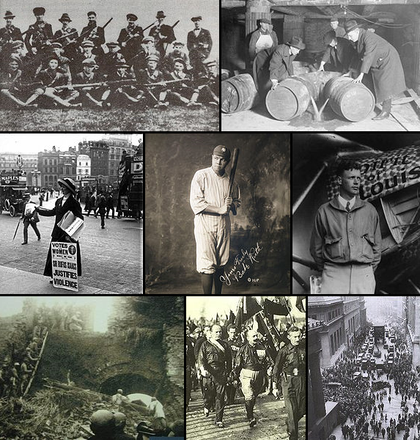
From left, clockwise: Third Tipperary Brigade Flying Column No. 2 under Seán Hogan during the Irish War of Independence; Prohibition agents destroying barrels of alcohol in accordance to the 18th amendment, which made alcoholic beverages illegal in the United States throughout the entire decade; In 1927, Charles Lindbergh embarks on the first solo nonstop flight from New York to Paris on the Spirit of St. Louis; A crowd gathering on Wall Street after the 1929 stock market crash, which led to the Great Depression; Benito Mussolini and Fascist Blackshirts during the March on Rome in 1922; the People's Liberation Army attacking government defensive positions in Shandong, during the Chinese Civil War; The Women's suffrage campaign leads to numerous countries granting women the right to vote and be elected; Babe Ruth becomes the most famous baseball player of the time.
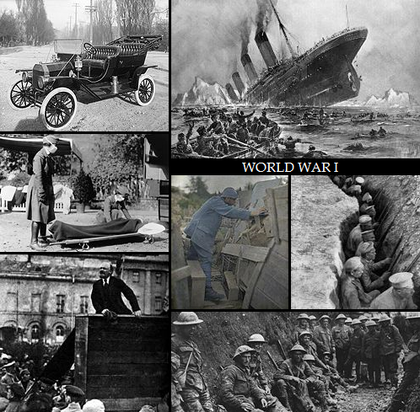
From left, clockwise: The Ford Model T is introduced and becomes widespread; The sinking of the RMS Titanic causes the deaths of nearly 1,500 people and attracts global and historical attention; Title bar: All the events below are part of World War I (1914–1918); French Army lookout at his observation post in 1917; Russian troops awaiting a German attack; A ration party of the Royal Irish Rifles in a communication trench during the Battle of the Somme; Vladimir Lenin addresses a crowd in the midst of the Russian Revolution, beginning in 1917; A flu pandemic in 1918 kills tens of millions worldwide.

From left, clockwise: The Wright brothers achieve the first manned flight with a motorized airplane, in Kitty Hawk in 1903; A missionary points to the severed hand of a Congolese villager, symbolic of Belgian atrocities in the Congo Free State; The 1908 Messina earthquake kills 75,000–82,000 people and becomes the most destructive earthquake ever to strike Europe; America gains control over the Philippines in 1902, after the Philippine–American War; Rock being moved to construct the Panama Canal; Admiral Togo before the Battle of Tsushima in 1905, part of the Russo-Japanese War, leading to Japanese victory and their establishment as a great power, while Russia's defeat eventually led to the 1905 Revolution.
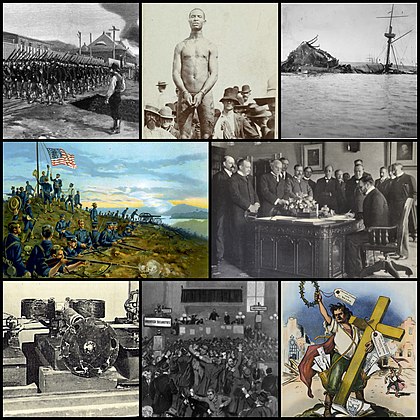
From left, clockwise: Union workers at a Carnegie Steel plant go on a strike later known as the Homestead Strike in 1892; Plessy v. Ferguson establishes the doctrine of racial segregation and leads to Jim Crow laws; USS Maine sinks in Havana Harbor in 1898 sparking the Spanish-American War; U.S. pays $20 million to get the Philippines from Spain in the Treaty of Paris; a cartoon mocks the Cross of Gold speech given by William Jennings Bryan who argues against the gold standard; Panic of 1893 instigates an economic depression which lasts for most of the 1890s; Thomas Edison invents the kinetograph, an early example of motion-picture technology; US Marines hoist a US flag during the land campaign of Cuba in the Spanish-American War.

From left, clockwise: A famous gunfight erupts at the O.K. Corral in Tombstone, Arizona in 1881; a long-distance passenger train called the Orient Express begins running between Paris and Constantinople in 1883; U.S. Congress bans Chinese immigrants from entering the U.S. for ten years, starting in 1882; South Fork Dam fails after heavy rainfall and floods the town of Johnstown, Pennsylvania, killing over two thousand people; George Eastman introduces the Kodak No 1 and the camera becomes an enormous success; Chicago's Haymarket Square is the scene of a bombing that kills at least seven police officers and four civilians during a massive protest from a labor rally and is generally considered the origin of modern May Day protests; settlers try to claim land during the Oklahoma Land Rush of 1889; combined groups of British and Sudanese forces on opposing sides fight during a nationalist uprising against the Khedive Tewfik Pasha.

From left to right, clockwise: Conflict erupts between the Second French Empire and the Kingdom of Prussia leading to the Franco-Prussian War in 1870; a fire in Chicago kills approximately 300 people and leaves about another 100,000 people homeless in 1871; Claude Monet's Impression, Sunrise is recognized as the source of inspiration for the Impressionist movement; The U.S. Army is defeated by Arapaho, Lakota and Northern Cheyenne tribes during the Battle of the Little Bighorn in 1876; Nicolaus Otto patents the first commercial four-stroke internal combustion engine; Queen Victoria is recognized as the “Empress of India” in the Royal Titles Act 1876; Emirate of Afghanistan forces defend against British Raj invaders in the Second Anglo-Afghan War; British Empire and Zulu Kingdom fighters engage in combat during the Anglo-Zulu War.

From top left, clockwise: Scottish physicist James Clerk Maxwell formulates the classical theory of electromagnetic radiation, bringing together for the first time electricity, magnetism, and light as different manifestations of the same phenomenon; the Meiji Restoration leads to enormous changes in Japan's political and social structure; the International Workingmen's Association is formed in 1864, aimed at uniting a variety of different left-wing socialist, communist and anarchist groups; the Battle of Avay, fought in 1868 during the Paraguayan War, the bloodiest inter-state war in Latin America's history; execution in 1867 of Maximilian I of Mexico, ruler of the Second Mexican Empire, established during the Second French intervention in Mexico; the Battle of Gettysburg, the turning point of the American Civil War, fought in the United States from 1861 to 1865, between the North (the Union) and the South (the Confederacy) as a result of the long-standing controversy over the enslavement of black people; the Suez Canal is inaugurated in 1869; Victor Emmanuel meets Garibaldi near Teano in 1860, at the end of the Expedition of the Thousand.

From left, clockwise: Henry Clay introduces the Compromise of 1850 the U.S. Senate; Harriet Beecher Stowe publishes Uncle Tom’s Cabin; Russian forces fight against British, French and Ottoman forces in Sevastopol during the Crimean War; SS Arctic, an American steamship, sinks in the Atlantic Ocean after a collision with a French steamship, SS Vesta in 1854; The Panama Railroad opens in 1855 connecting the Pacific and Atlantic Oceans with a railroad in Central America; Anglo-French and Qing Empire forces engage each other in a four-year long campaign known as the Second Opium War starting in 1856; Dred Scott v. Sandford denies American citizenship as mandated under the U.S. Constitution to African Americans; Charles Darwin publishes On the Origin of Species in 1859, presenting the idea of natural selection.

From top left, clockwise: Mexican-American War was a conflict that ushered the American expansion in its western frontier, paving way for new territories (and eventually states) such as Texas and California; Treaty of Waitangi in 1840 resulted with the establishment of New Zealand as a British colony, symbolizing Britain's rising power and expansion to new reaches, particularly in the New World, where demand for imperial power and trade control increases; The great auk goes extinct, as it falls victim to overhunting; First Opium War catalyzed Europe's imperial encroachment and control over Chinese ports, as the war resulted with Hong Kong's succession to Britain via the Treaty of Nanking; The Oregon Trail opens up to the world, prompting a wave of migration to the American west and later on, a gold rush in California that persisted through the 1850s; The saxophone was patented and released to the public, forging way for future music genres such as jazz, swing, and blues; First edition of the Communist Manifesto was published by Karl Marx in February 1848. This publication would go on to create a revolutionary shift in political ideologies and thought in the 20th century, influencing entire states such as Soviet Union, China, and Cuba; the Revolutions of 1848 ravages European politics, and causes multiple socio-cultural changes, particularly in classical music, arts, and politics.

From top left, clockwise: Queen Victoria's coronation marked the beginning of her 64-year long reign. Her reign meant the revival of the British Empire, as the United Kingdom rapidly grew powerful territorially and economically. Under her rule, Britain saw a massive upheaval of colonial power, as over a quarter of the world fell into British rule; France's 1830 revolution reinstated liberal values – and later French imperialism – back into French governance and power. The revolution resulted in the dethroning of King Charles X and indirectly rebirthed the French colonial empire; Michael Faraday and John Daniell's studies helped form the basis of electrochemistry via the discovery of electromagnetic induction. Their discoveries moulded a huge part of contemporary chemistry, and forever changed the way people utilized electricity; HMS Beagle circumnavigates the world twice. Its second expedition with Charles Darwin has proven to be particularly pioneering, as the discoveries and theories he made on said voyage, helped him develop the theory of evolution, widely enhanced scientific consensus and knowledge on taxonomy and biology, and birthed the concept of natural selection; Slave and free states grow in number and power; a dynamic movement widely perceived as a prelude to the American Civil War as abolishment and establishment began to socio-politically polarize the United States' society, subsequently forming Union and Confederate states; The telegraph is invented by Samuel Morse. His patent opened the world to global networking and broke long distances as boundaries with it – the first of its kind; an 1832 still-life image developed by a daguerrotype. The daguerreotype was first introduced to the public in 1839. Its release made it the first invention that enabled the public to capture images on a recurrent basis – a move that would eventually nurture the growth of modern-day photography; Hans Christian Andersen publishes his first collection of fairy tales in 1837. His publications profoundly transformed literature, and grew to become one of the most popular and influential storywriters of the 19th century, with stories like The Little Mermaid (as pictured), and Thumbelina; a legacy that today retains as Denmark's national icon.
错误:图像不正确或者不存在。

From top left, clockwise: The Battle of Waterloo signified the end of Napoleon's conquests, as it sealed the downfall of his empire and brought his campaigns to an end; The French invasion of Russia and the subsequent retreat from Russia's harsh winter proved to be a turning point in the Napoleonic Wars, as food shortages and drastic supply loss led to catastrophic French losses from which Napoleon would never recover; The stethoscope was invented – its first prototype made by Frenchman René Laennec could be shown here. His invention proved to be an innovation that changed the course of medical diagnosis and overall medicinal sciences; Mount Tambora's eruption in 1815 – the world's largest volcanic eruption in recorded history – inflicted over 90,000 human deaths, a cycle of famines, and a series harsh winters over the next few years, in a period that would be known as the Year Without a Summer. Its global impact had arguably made its eruption the world's most influential –and worst– volcanic eruption on contemporary history; - War of 1812 was fought over Canada and the U.S, and largely involved the struggle between remnants of British imperialism on the continent, with the then-fledgeling nationalist movements that sprung as the aftermath of the American Revolutionary War and the United States' independence. It is widely considered as a spillover political conflict of the Napoleonic Wars; The Great Comet of 1811 made a brief appearance. Observations made by amateur scientists evolved modern-day understanding of comets, and eventually forged a way for astronomy knowledge; Theory of Colours was first published. The German-made theory helped inspire countless of visual arts and design concepts in the future, as well as nurturing further understanding on colours; The gas light becomes widely implemented into urban systems – mainly as streetlights – after its inception on the 1800s.

From top left, clockwise: Napoleon Bonaparte is crowned Emperor of the French Empire and embarked on trans-European conquests, which would later on be best known as the Napoleonic Wars – a conflict that forever transformed European politics, and gave rise to the global struggle for hegemony; Ceres was discovered, proving the existence of an asteroid belt between the Solar System's inner and outer planets; Inventor Isaac de Rivas created a hydrogen gas-powered vehicle, an inception to automotive engineering and internal combustion engines; - The Louisiana Purchase was made, singlehandedly expanding the United States of America in a scale larger than ever; to this day the purchase is still viewed as one of the largest expansions within North America to date; Symington's Charlotte Dundas became the world's first functioning steamboat; Haiti declares independence in 1804, becoming the world's very first black-led republic and the first independent Caribbean state, with its victory marking the world's arguably only successful slave revolution in history; Morphine is successfully isolated from opium and is produced for the first time as a separate medicinal product in 1804; Francis II abdicates in 1806, thus dissolving the Holy Roman Empire.

From top left, clockwise: Atlantic slave trade and abolitionism gain momentum over Europe and the Americas, as bans began to be enacted in countries such as Denmark-Norway (1803), the United Kingdom (1807), and Union States of the United States (1808) in the subsequent decade, following movements and upheavals of awareness at this period; Now-iconic Peking opera was conceived after the Four Great Anhui Troupes were brought into the dynasty capital to perform in Beijing, sometime in 1790; The metric system is formally adopted for the first time in France after receiving recommendation from its Commission of Weights and Measures. This set the metric system as a global default of measures and trail-blazed its universal acceptance as the standard of measures, outpacing the imperial system in the process; Smallpox vaccine was created in 1796 by British doctor Edward Jenner; a patent that would unknowingly lead to the eradication of smallpox, directly contributing to the world's first and only successful disease eradication campaign; The United States' very first contested presidential elections took place in 1796, who was eventually won over by John Adams; The cotton gin was first formally patented and came into industrial use in 1793, by American Eli Whitney. The modernized version of the engine paved way for much of the Industrial Revolution and enabled the textile industry to evolve and flourish more, due to its ability to separate cotton; French Revolutionary Wars broke out and culminated at this decade, where events such as the Reign of Terror (pictured) and the establishment of the French First Republic set off frenzied politics, birthing the idea of modern-day political spectrum in the process; Lithography was invented, revolutionising print methods, and increasing pragmatism over information processing.

From top left, clockwise: - The fall of the Bastille propelled the start of the French Revolutionary War, a war that will eventually influence global politics by the birth of democracy in governments, and conceive the idea of republicanism worldwide; The first hydrogen balloons flew successfully this decade by Jacques Charles and Nicolas-Louis Robert; George Washington becomes president of the United States of America. His ascension into office marked him as America's first president; The United States Constitution is signed in Philadelphia, formally ending the American Revolutionary War against the United Kingdom; Uranus is discovered in 1781 by William Herschel, further expanding the global scientific consensuses and understanding on the Solar System, recognizing it as the seventh planet from the Sun; The Iron Bridge opens, making it the world's very first bridge made out of cast iron, ushering in the preliminary wave of the Industrial Revolution; The Montgolfier brothers manned the world's first hot-air balloon, which stayed afloat 2 kilometres above ground in its 1783 voyage; Icelandic volcano Laki erupted in 1783, unleashing an 8-month-long environmental destruction and widespread famine across Europe. Up to 33% of Iceland's population and tens of thousands more in Mainland Europe succumbed to the chain of disasters, leading the eruption to be dubbed as "one of the worst" in contemporary history.

From top left, clockwise: Englishmen and sailor James Cook concludes his inaugural and embarks on his second voyage, leaving a trail of significant milestones along its way such as the discovery of New Caledonia, Australia, Tahiti, the Antarctic Circle, and becoming the first humans to witness Antarctic waters as pictured; The United States Declaration of Independence was unanimously signed and adopted by the Second Continental Congress, announcing the colonies' intention to separate from Great Britain; Company rule in India establishes governance over India for the first time at Calcutta, giving way for British colonialism over the Indian subcontinent, and eventually Western imperialism in Asia; Nitrogen gas was isolated from air by Scottish scientist Daniel Rutherford; Amazing Grace was sung for the first time as a hymn in Buckinghamshire, England at 1773; Chemist Carl Wilhelm Scheele made several breakthroughs in chemistry by discovering five chemical elements, namely oxygen (1771), barium (1772), chlorine (1774), manganese (1774), and molybdenum (1778); The Boston Tea Party protest precipitates anti-British sentiment in the Thirteen Colonies, and subsequently the American Revolutionary War; A Russo-Turkish War lead to now-Russia's first occupation of Crimea; initiating Russia's influence over Crimea that has since persisted today.

From top left, clockwise: English Explorer James Cook commenced his first voyage around the world and becoming the first known Europeans to reach the east coast of Australia; victory at the Battle of Buxar and subsequent Treaty of Allahabad marked start of the political and constitutional involvement East India Company and the beginning of British rule in India; the Dutch ship, the Meermin is taken over by the slaves it was transporting in the Meermin slave mutiny; George III is crowned king of the United Kingdom and would go on to reign longer than any of his predecessors; French inventor Nicolas-Joseph Cugnot built the world's first full-size and working self-propelled mechanical land-vehicle, the "Fardier à vapeur" — effectively the world's first automobile; the Stamp Act is passed by the British parliament required that many printed materials in the colonies be produced on stamped paper produced in London. The unpopularity of the Stamp Act, and other such taxes levied by the parliament would contribute to the start of the American revolution; Leopold Mozart and his family toured Europe allowing their children to experience to the full the cosmopolitan musical world which in Wolfgang's case this would continue through further journeys in the following six years, prior to his appointment by the Prince-Archbishop as a court musician; the signing of the Treaty of Paris formally ended the Seven Years' War and marked the beginning of an era of British dominance outside Europe.

From top left, clockwise: The Treaty of Madrid amends the pre-existing Treaty of Tordesillas (1494). Signed in 1750, this Spanish-Portuguese agreement, enabled Portugal to claim more holdings in what is now Brazil; Dzungar Khanate is captured by Qing forces in 1755, ultimately transferring Xinjiang into the hands of Han Chinese power – a legacy that continues to this day in modern-day China; A destructive earthquake and tsunami ravages the city of Lisbon in 1755, strongly influencing the studies of engineering, as well as philosophical thoughts on the Western Age of Enlightenment; Britain's victory during the Battle of Quiberon Bay signalled the rise of the British Navy's power, as it heightens its ranks of becoming the world's foremost naval power, and a dominant global entity for the next two centuries; Halley's Comet appears accurately from scientific projections for the first time in 1759; Artificial refrigeration is invented and first used in 1758 under the studies of Scottish physician and chemist William Cullen; The precipitation of the French and Indian War in 1754 proved to become one of North America's first major interstate conflicts, and one of the largest to significantly involve Native American tribes such as the Iroquois, the Cherokee, and the Mi'kmaqs; Benjamin Franklin conducts his now-iconic kite experiment in 1752, leading him to the discovery of electricity and the invention of lightning rods.

From top left, clockwise: The War of Jenkins' Ear, a conflict between the British and Spanish Empires lasting from 1739 to 1748. The War of the Austrian Succession from 1740 to 1748, caused by the death of Emperor Charles VI in 1740. The siege of Trichinopoly a conflict between the Nizam of Hyderabad and the Maratha Empire over the Carnatic region. George Anson burns Paita, a settlement in Peru in 1742 whilst on a voyage around the world. Nader Shah declares war on the Ottoman Empire in 1743 resulting in the Ottoman–Persian War. Following the end of the First Silesian War in 1742, the Second Silesian War occurs as a continuation of the first war. A Leyden jar is discovered independently by Ewald Georg von Kleist and Pieter van Musschenbroek. The Jacobite rising of 1745, an attempt by Charles Edward Stuart to regain the British throne for his father.









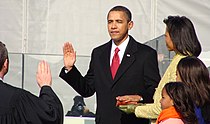

_after_crashing_into_the_Hudson_River_(crop_2).jpg/210px-US_Airways_Flight_1549_(N106US)_after_crashing_into_the_Hudson_River_(crop_2).jpg)


.jpg/140px-Michael_Jackson_Star_on_Hollywood_Blvd_(cropped).jpg)



.jpg/209px-Donald_Trump_(30504739957).jpg)


.jpg/139px-Boatleave_-_10_(27661060226).jpg)






_9M-MRO_-_MSN_28420_404_(9272090094).jpg/139px-Boeing_777-200ER_Malaysia_AL_(MAS)_9M-MRO_-_MSN_28420_404_(9272090094).jpg)
.jpg/139px-Opening_of_XXII_Winter_Olympic_Games_(2338-07).jpg)


.jpg/139px-Free_libya_from_Gaddafi_(5510126745).jpg)
.jpg/139px-South_Sudan_Independence_Celebration_(5963420792).jpg)




.jpg/139px-Otakuthon_2014-_Minecraft_(14843122997).jpg)







.jpg/139px-2010.11.23_북한_해안포_발사로_불타는_연평도_(7445571570).jpg)


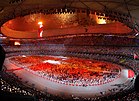
.jpg/209px-Independence_Day_in_Kosovo_(2282939677).jpg)






.png/139px-Me_at_the_zoo_(screenshot).png)

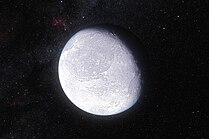









.png/139px-Napster_running_on_an_original_iBook_(2001-03-11).png)


_-_09.jpg/220px-Queen_Elizabeth_II%27s_Funeral_and_Procession_(19.Sep.2022)_-_09.jpg)